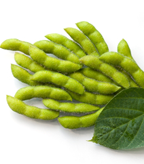Higher Soy Intake Associated With Longer Survival in Lung Cancer
Women with lung cancer who ate more soy prediagnosis appear to survive longer than patients who ate fewer soy-based foods, according to a new Chinese study.
Women with lung cancer who ate more soy prediagnosis appear to survive longer than patients who ate fewer soy-based foods, according to a new Chinese study.

“Estrogen signaling has been shown to promote lung cancer progression, and this estrogen-induced tumor progression can be blocked by estrogen receptor (ER) antagonists or aromatase inhibitors,” wrote study authors led by Gong Yang, MD, of Vanderbilt University School of Medicine in Nashville, in the Journal of Clinical Oncology. “Plant-derived estrogens, such as isoflavones found mainly in soy food, appear to act as natural selective estrogen receptor modulators.” Previous work by this group based on data from the Shanghai Women’s Health Study showed a significant inverse association between soy intake and lung cancer risk among nonsmoking women; in this study, they hypothesized that soy consumption would affect cancer outcomes among those already diagnosed.
The study included 444 patients with lung cancer in the Shanghai Women’s Health Study; the mean age at diagnosis was 66.3 years, and 92% of the cohort had never smoked. During the follow-up period (median 36 months, range 17 to 77 months), 318 patients died. Lung cancer was the primary cause in 301 of those patients.
In general, patients who consumed more soy-based food had better survival than those who consumed less. The adjusted survival rate at 12 months for patients in the highest tertile of soy intake was 0.60 (95% CI, 0.51–0.69), and 0.50 (95% CI, 0.40–0.60) for the lowest tertile of soy intake. “The risk of death decreased with increasing soy food intake until the intake level reached approximately the 70th percentile; further increases in soy intake did not appear to convey additional benefits,” the authors wrote.
The researchers conducted an adjusted analysis and found the hazard ratio for total mortality associated with the 10th percentile of soy intake was 1.81 (95% CI, 1.26–2.59) compared with median intake. The 30th, 70th, and 90th percentiles of soy intake yielded HRs of 1.25 (95% CI, 1.09–1.42), 0.88 (95% CI, 0.80–0.97), and 0.89 (95% CI, 0.68–1.16), respectively (P = .004).
Those hazard ratios were more pronounced among only patients who never smoked. The lowest percentile of soy intake had an HR of 2.40 (95% CI, 1.47–3.91), while the 70th percentile had an HR of 0.85 (95% CI, 0.76–0.96; P = .002).
“This finding, along with our previous observation of an approximately 40% reduction in risk of incident lung cancer associated with high intake of soy food, provides further support for the role of soy food intake in lung cancer development and prognosis,” the authors wrote. Though the mechanisms by which soy modulates risk and outcome are probably various, the authors noted that soy isoflavones can compete with endogenous estrogens in binding to receptors, as well as possibly acting as a tyrosine kinase inhibitor.
“More epidemiologic studies are needed to confirm this finding and provide support for launching randomized trials,” the authors wrote. Because soy is generally readily incorporated into diet, the finding could help with development of new management strategies for lung cancer in the future.